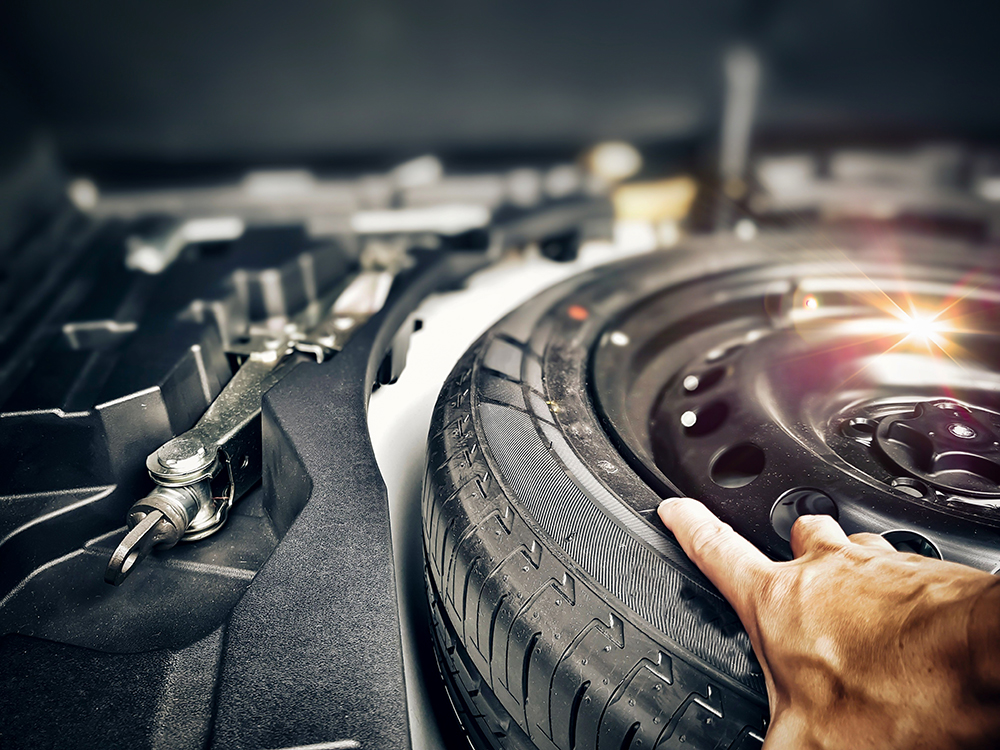Tips for Maintaining and Driving on a Spare Tire

A flat tire can happen unexpectedly and leave you stranded on the side of the road. In such situations, a spare tire can be a lifesaver – allowing you to continue your journey until you can get the damaged tire repaired or replaced. However, driving on a spare tire requires a different set of considerations than regular tires. What’s unique? Let’s review some of our best tips for maintaining and driving on a spare tire, ensuring both the longevity of the spare and, more importantly, your safety.
Understand Your Spare Tire
Spare tires come in different types: full-size, compact, and temporary (also known as "donut" spare tires). Full-size spares are identical to the regular tires and can be used like a regular tire. Compact and temporary spares are designed for short-term use and at limited speeds. Familiarize yourself with the type of spare tire your vehicle has, its recommended usage, and speed limitations.
Check Air Pressure Regularly and Monitor Tread Depth
Just like regular tires, maintaining the proper air pressure in a spare tire is crucial. Check the spare tire's air pressure at least once a month and before embarking on long journeys. The recommended air pressure can usually be found in your vehicle's owner's manual or on a sticker inside the driver's door frame.
While spare tires aren't intended for long-term use, it's still important to ensure that the tread depth is adequate. If you’ve used your spare tire before, or are actively using it now, tread depth is a crucial consideration. A deeper tread provides better traction, especially in adverse weather conditions like rain, snow, or ice. If the spare tire's tread depth is too low, it might compromise your vehicle's stability and handling. The reduced traction and handling capabilities of a spare tire can make your vehicle more vulnerable to skidding or loss of control.
Take It Easy: Limit Your Speed, Ovoid Overloading, and Keep to Short Distances
Temporary or compact spare tires are not designed for high speeds. Most manufacturers recommend driving at speeds no greater than 50-55 mph when using a temporary spare. Excessive speed can generate excess heat and stress, potentially leading to a blowout.
Also of note: Spare tires, particularly temporary ones, have a lower load-carrying capacity than regular tires. Avoid overloading your vehicle when driving on a spare tire, as excessive weight can damage the spare and compromise your safety on the road.
You should also stick close to home, or limit your driving to only the most important destinations. Temporary spare tires are not meant for extended travel. They lack the durability and performance characteristics of regular tires. As soon as you install a spare tire, aim to reach a tire repair shop as quickly as possible to either repair or replace the damaged tire.
Replace Your Spare Tire ASAP
A spare tire is a temporary solution. Once you have a flat tire, it's essential to address the issue promptly by either repairing or replacing the damaged tire. Continuing to drive on a spare tire for an extended period can compromise your safety and negatively impact your vehicle's handling and stability. Temporary solutions like tire sealants might help in emergency situations, but they are not a substitute for proper tire repair or replacement.
If you need to replace more than one tire, try to match the type and brand of the new tires to the ones already on your vehicle. Mixing different tire types can lead to uneven wear and handling imbalances.
Have a Flat? Using a Spare? Stop by Metro Motor
Maintaining and driving on a spare tire requires awareness and caution. While spare tires provide a temporary solution, following these tips will help ensure your safety, your vehicle's performance, and the longevity of both your spare and primary tires. Remember, while a spare tire can get you back on the road, it's always best to address the underlying tire issue promptly to avoid further complications.
That’s where Metro Motor can help. With conveniently-located auto repair and maintenance shops across Washington, D.C., Northern Virginia, and Maryland, we have all the tools and training to order and install replacement tires and spares. Simply request an appointment or stop by a location today. If you don't have a spare tire or your car isn’t safe to drive, we can even send a tow truck to collect the vehicle. We’re always here when you need us!
Vehicle care information made available by Metro Motor is presented as helpful advice for general maintenance and should not be construed as instructions for at-home vehicle service. Be sure to consult your owner’s manual and a licensed, professional mechanic for diagnostics and repair.
